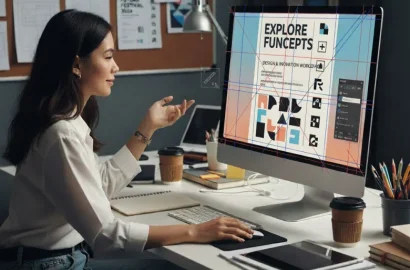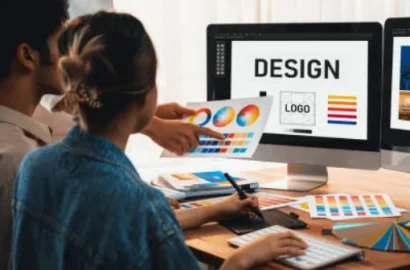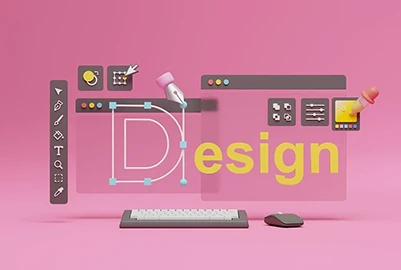Is software training sufficient to become a graphic designer? What other skills are needed to excel in the field? Read on for a comprehensive understanding of the scope of graphic design and why it cannot be mastered through software proficiency alone.
If you’re passionate about graphic design and believe that mastering software is the key to success in this field, you’re not alone. The demand for technical skills in the job market for this design discipline has led to a prevailing misconception that proficiency in software alone equates to graphic design expertise. However, this notion couldn’t be further from the truth.
While software skills are undoubtedly essential for graphic designers, the field of graphic design is far more nuanced and multifaceted. Mastering software tools is just one aspect of excelling in the industry and aspiring graphic designers often need a comprehensive and dynamic skillset that goes way beyond mere software proficiency.
Through this article, we intend to debunk the myth that software training equates to prowess in graphic design and provide insights into the diverse skill set required to thrive as a graphic designer.
Contents:
- What is the role of a graphic designer?
- Skills needed to become a graphic designer
- How does software proficiency benefit a designer?
- Why software proficiency alone cannot make you a designer
- How to learn graphic design?
What is the role of a graphic designer?
While graphic design is often associated with creating visually appealing designs, the actual scope of the field encompasses much more than that. Graphic designers strive to translate and convey key information through visual design that both resonates with viewers and attracts their attention. That’s one of the major reasons why experts in the field play an integral role today in marketing, advertising, and branding, where visual design becomes essential to help communicate and elicit specific emotions in viewers.
As a branch of visual communication that has vast applications, the actual role of a graphic designer varies based on the industry or niche they’re working in. Brand and visual identity, print design, packaging design, editorial and publishing, motion graphics, and animation are a few common job profiles that such designers typically specialize in.
However, regardless of the specialization, the overarching role of a graphic designer remains consistent: crafting visual solutions for effective communication. To achieve the same, one must have a knack for playing around with color, typography, layout and other visual elements. In other words, a graphic designer must possess a dynamic skillset. Read on for a detailed walkthrough of each of these skills.

Essential Skills to Become a Graphic Designer
While technical proficiency in software such as Adobe Photoshop, Illustrator, and InDesign is important for a graphic designer, it’s just one piece of the puzzle. In reality, graphic design encompasses a diverse set of hard and soft skills.
Aspects such as understanding the brief, communicating with the client and creating unique products require knowledge of graphic design principles, design thinking, and soft skills such as suave communication and the will to collaborate.
Here’s a brief breakdown of some of the essential graphic design skills:
Hard Skills
Knowledge of graphic design principles
This includes a deep understanding of fundamental principles like balance, hierarchy, contrast, proportion and repetition. These are foundational concepts that allow designers to understand shape and form and consequently create aesthetically pleasing and purposeful designs.
Understanding of color theory and psychology
Colors play a key role in attracting viewer attention and eliciting specific emotions. A working knowledge of color theory and psychology equips graphic designers to understand what can nudge customer behavior, mood, and action, in the desired direction. Similarly, a knowledge of typography and its interaction with color is an essential skill for designers in this field.
Knowledge of branding
Whether designing for websites, posters, social media or advertising, elements of branding are almost always incorporated into visual themes to create a unique and consistent identity. Understanding the relationship between visual design and branding is therefore a key skill that graphic designers must possess.
Soft Skills:
Communication and collaboration
Graphic designers almost never work in isolation and have to constantly collaborate with clients and stakeholders. Understanding the design brief, asking the right questions, discussing end objectives, and managing expectations all require good communication skills.
Problem solving abilities
Every client demand and brief is essentially a problem statement that needs to be solved through the means of graphic design. Knowledge of design thinking, in particular, can be crucial for understanding and solving complex visual communication challenges. This includes familiarity with research, ideation, prototyping, and iteration to create effective designs that meet the needs of both clients and audiences.
Creativity and attention to detail
The ability to think outside of the box and produce unique solutions is the core of graphic design. Unlike popular notions, creativity can be developed through a systematic approach. This is another aspect where design thinking can help strategically produce solutions that are unique and impactful. Attention to detail becomes crucial when designing or even reviewing designs to make sure they meet brand guidelines
How does software proficiency benefit a graphic designer?
Software proficiency is undoubtedly one of the most important skills to excel as a designer today. This is chiefly due to rapid digitisation where most customer interactions occur on digital platforms. Even traditional and non-digital products like posters or brochures are now crafted digitally rather than by hand.
As a technical skill, hence, hands-on knowledge of software allows designers to deliver their vision effectively. Some key graphic design tools that a designer should have proficiency in include:
- Adobe Illustrator
- Adobe Photoshop
- Adobe InDesign
- Adobe Premiere Pro/ After Effects/ Animate
Most organizations, in fact, look for graphic designers who are adept at software operation and wouldn’t ideally need to be dependent on other teams to translate their designs into creatives or collateral. Be it for creating simple, template-based designs or whipping up complex graphics from scratch— the right software knowledge is key to ensuring graphic designers realize their creative vision and get the job done!

Why software proficiency alone cannot make you a graphic designer?
Software proficiency, in practice, only equips designers to bring their vision to life. Knowledge of software like InDesign or Photoshop will allow a designer to make logos, posters, banners or websites. However, it cannot help designers address questions like ‘what are the most appropriate visual elements to use to convey a message?’ Decisions like ‘whether a static post or dynamic video would better engage the target audience’ cannot be addressed through only software proficiency.
Mastery of a tool can, at best, allow an individual to craft an aesthetically pleasing design. However, the thought, reasoning and decisions that go behind creating an impactful design cannot be addressed through software proficiency.
Take this scenario for instance: Imagine you’re a graphic designer tasked with creating a social media ad to boost event registrations. In this process, you’d need to carefully select the layout, typography, and color choices based on audience behavior and patterns graphic design principles and backed by a design thinking approach. However, if you’re solely trained in software operation, you’ll lack the ability to take an objective stance, resulting in arbitrary decisions that are unsustainable in the long run.
Questions of such nature can only be addressed if one is trained in key principles and intricacies of design thinking. Without such design knowledge, one cannot truly become a graphic designer and might even be restricted to the role of a software operator.
How to learn Graphic Design?
If you are interested in becoming a skilled graphic designer, it is recommended to focus on developing a holistic skillset. You can consider the following steps or ways to gain a thorough understanding of the field:
- Learn the basics: Start by exploring the foundational principles and theories that govern the field. This would also equip you to understand the right application of various software functions and features and attain optimal results.
- Explore tools and software: Once you’ve established a solid design foundation, advance to software exploration and training. Begin with industry-standard design software like Adobe Photoshop, Illustrator, and InDesign. These tools are paramount for your skill development and proficiency in the field.
- Enrol in a formal course: Enrolling in formal education via a graphic design course offers one of the most comprehensive approaches to grasp the nuances of the field. By studying alongside experts and applying your knowledge in a structured environment, you’ll be equipped with the skills needed to thrive in the industry. This guided learning experience ensures you’re thoroughly prepared for industry and workplace challenges.
- Gain practical experience: Practice is key to mastering graphic design. Dedicate time to work on design projects regularly, whether it’s creating mock-ups, redesigning existing designs, or participating in design challenges. Experiment with different styles, techniques, and tools to expand your skills. Hands-on experience can go a long way when looking to establish yourself in this design specialization.
- Build a relevant portfolio: A strong design portfolio serves as your passport to the industry, showcasing your talent, skills, and design process. It’s essential to include your entire design cycle in the portfolio, from initial brainstorming to final designs. For inspiration on the types of projects to include, take a look at this Brand Identity Project by AND learner Akhil N.
Next Steps
We hope that through this article we’ve been able to establish why software proficiency alone would not be enough if you’re looking to establish yourself as a graphic designer.
If you still have unanswered questions about pursuing graphic design, consider these additional resources for further information:
- Watch this session by graphic design industry leaders Soumya Tiwari and Sakshi Jain.
- Talk to a course advisor to discuss how you can transform your career with one of AND Academy’s courses.
- Explore our Graphic Design Course, which is taught through live, interactive classes by industry experts, and comes with a job guarantee.
- Take advantage of the scholarship and funding options that come with our courses to overcome any financial hurdle on the path of your career transformation.
Note: All information and/or data from external sources is believed to be accurate as of the date of publication.









